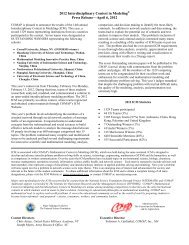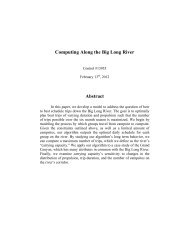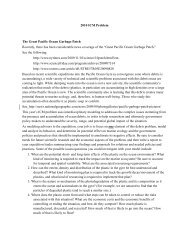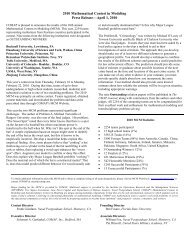Centroids, Clusters and Crime: Anchoring the Geographic Profiles of ...
Centroids, Clusters and Crime: Anchoring the Geographic Profiles of ...
Centroids, Clusters and Crime: Anchoring the Geographic Profiles of ...
You also want an ePaper? Increase the reach of your titles
YUMPU automatically turns print PDFs into web optimized ePapers that Google loves.
Team # 7507 Page 15<br />
tiveness multiplier serving as a representation <strong>of</strong> our model’s utility in a general case <strong>of</strong> serial<br />
crime.<br />
6 Two Schemes for Spatial Prediction<br />
As discussed in <strong>the</strong> Background, <strong>the</strong> problem <strong>of</strong> predicting next crime location is not well<br />
documented. The most common approach to analyzing a criminal crime sequence is to predict<br />
a home location. The research literature on journey-to-crime research for violent serial crimes<br />
strongly suggests that serial crime is patterned around a criminals home, workplace, or o<strong>the</strong>r<br />
place <strong>of</strong> daily activity[15, 8, 4, 6, 17]. This has lead researchers to spend most <strong>of</strong> <strong>the</strong>ir resources<br />
developing <strong>and</strong> evaluating methods <strong>of</strong> finding this crime center point. The centroid is <strong>the</strong>n<br />
investigated as an anchor point in <strong>the</strong> criminal’s daily activity. For <strong>the</strong> majority <strong>of</strong> research,<br />
this anchor point is <strong>the</strong> serial criminal’s home. This method has been tested on large sets <strong>of</strong><br />
data <strong>and</strong> was found to reduce <strong>the</strong> necessary search area by a factor <strong>of</strong> ten.<br />
Our schemes will use <strong>the</strong> strength <strong>of</strong> an anchor point finding algorithm to predict likely<br />
locations <strong>of</strong> future crimes. The motivation is straightforward: if we know <strong>the</strong> location <strong>of</strong> an<br />
anchor point <strong>and</strong> <strong>the</strong> pattern <strong>of</strong> crime location from this anchor point, we can generate an area<br />
<strong>of</strong> future likely hood by projecting from <strong>the</strong> anchor point back to <strong>the</strong> crime points. It seems<br />
that this conceptualization <strong>of</strong> patterning is more accurate than a direct forecasting scheme that<br />
ignores anchor point behavior.<br />
We develop two schemes with <strong>the</strong> base assumption <strong>of</strong> <strong>the</strong> existence <strong>of</strong> anchor point patterning.<br />
The first scheme assumes only a single anchor point. The second scheme assumes<br />
multiple anchor points. These related schemes can <strong>the</strong>n be used in combination to provide an<br />
analysis <strong>of</strong> likely future crime locations.<br />
7 Single Anchor Point: Centroid Method<br />
Figure 2 is <strong>the</strong> algorithm used to predict likely crime locations using a single anchor point.<br />
Because <strong>of</strong> <strong>the</strong> use <strong>of</strong> centroid to calculate <strong>the</strong> single anchor, we call this <strong>the</strong> centroid method<br />
(although centroids will be used in both methods). Description <strong>of</strong> <strong>the</strong> algorithm <strong>and</strong> discussion<br />
<strong>of</strong> its results are presented. The green blocks in <strong>the</strong> diagram represent extensions <strong>of</strong> <strong>the</strong> model<br />
which will be discussed.
















